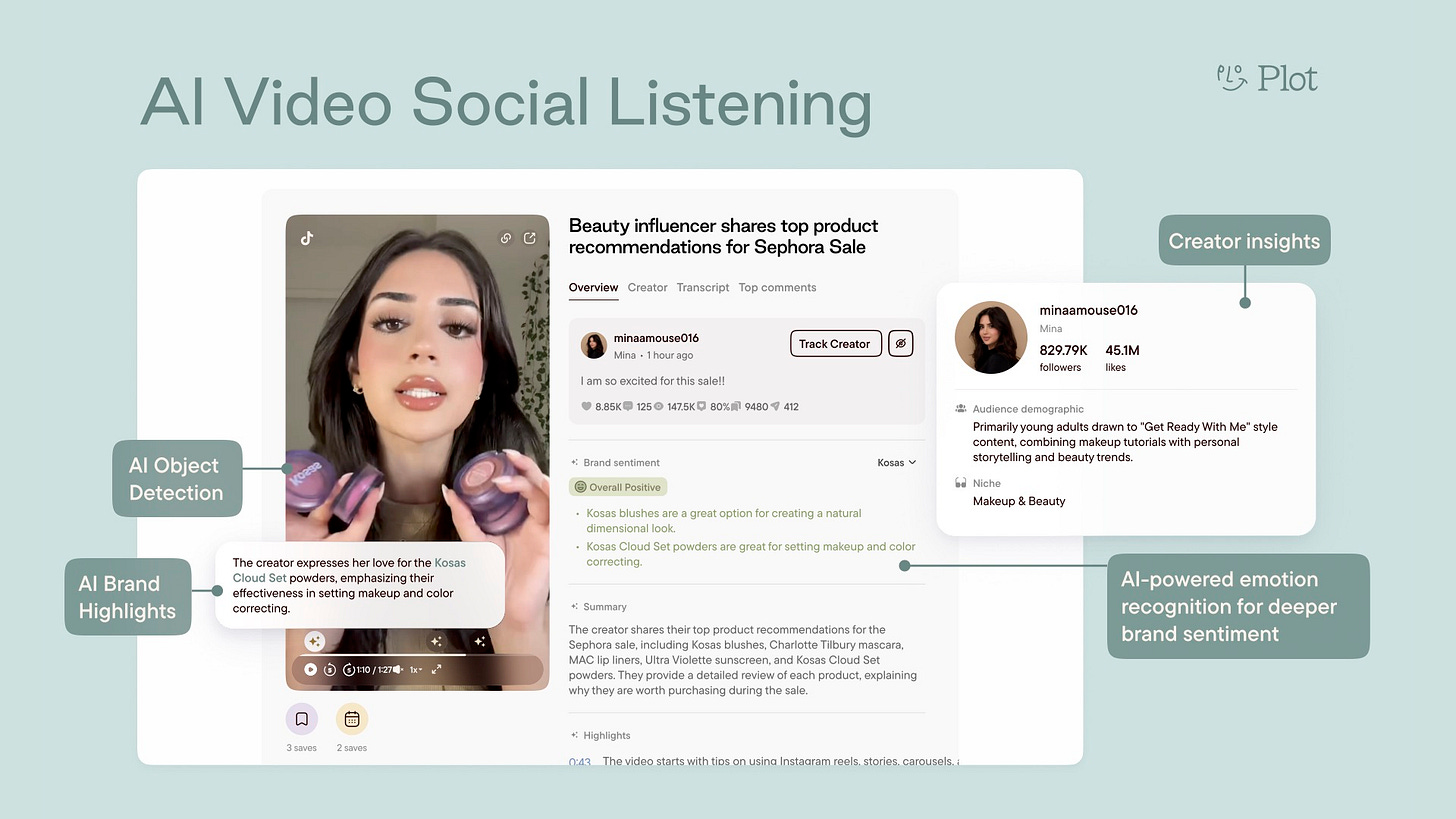TikTok Told You Their Real Thoughts But You Weren’t Listening
What happens when social listening misses the context consumers are screaming about.
Are you listening to how consumers are duping luxury brands?
There was a time when counterfeits lived in the shadows. I mean, have you ever walked by Canal Street in Manhattan and felt that weird tension when you passed a guy selling knockoff watches from a trench coat? You knew they were fake. He knew you knew. But still, there was something intriguing about scoring a dupe for a fraction of the price—something you’d swear was good enough to fool your friends. There was also a little bit of shame that came with making a purchase. Because back then, owning a fake anything meant you were hovering just outside the elite club. You didn’t talk about it. And you definitely didn’t post about it.
Fast forward to 2025. You’re watching someone holding up an $80 Walmes Wirkin bag on TikTok, comparing it side-by-side with a $30,000 Birkin, and calling it the smarter choice. And the comment section is full of support. No one’s embarrassed. If anything, they’re loud and proud.
This is what the defluencing era actually looks like. Status isn’t about logos anymore. It’s about logic. And the logic sounds a lot like: “Yeah, I could’ve paid more, but why would I want to?”
I know what you’re thinking: why is a marketer talking about dupes on her Substack? Well, it’s because I find this to be interesting and very much tied to what could happen if brands did proper social listening. The shift in consumer mindset wasn’t subtle. It was loud and pointed. And yet, I’m willing to bet most brands still didn’t hear it. Not because they weren’t paying attention, but because they were listening in the wrong places.
So this post isn’t really about knockoffs or savvy shopping. It’s about how smarter social listening—real listening—can inform business strategy. Consumers are generously giving you the full lowdown, and their communities are buzzing.
The state of listening: loud signals, mid tools
Legacy social listening tools are built to count things: mentions, hashtags, volume spikes. Great for campaign recaps. Absolutely useless for strategy.
Because while everyone is tracking noise, what actually matters is intent, tone, and the stuff people don’t say outright. And here’s what I keep noticing as an avid scroller: people are dragging brands without even naming them. But context clues, and a quick scroll through the comments, will tell you exactly who they’re talking about.
People are making purchasing decisions without tagging. They’re having rich, emotional conversations in videos and comments that would never show up in a traditional listening report—because those tools aren’t pulling them in. And they’re not pulling them in because they can’t.
That’s the gap.
Most brands probably don’t even know a more modern solution exists. Because we generally feel more comfortable with how things have always been versus trying something new. They’re still paying for legacy tools that have slowed down while the internet’s sped up (thanks, AI). And I can say this with both confidence and conviction because I’ve worked in social for over a decade. I’ve used pretty much every product you can name. Most of them don’t help you listen with intentionality. They just help you summarize.
That’s why I joined a team building something that fills this gap. But more on that later.
The real issue here is that most teams are optimizing for what’s easy to measure—not what’s actually important to understand.
[Case Study] Our team used Plot’s Video Social Listening to research the Dupe Movement
From February to April 2025, Plot analyzed over 1,700 TikToks and Instagram videos and 24,000+ comments about luxury bag dupes. Here’s what surfaced:
Post volume grew 10x in three months. And it wasn’t gradual. Literal floods.
Louis Vuitton and Hermès were the most talked about—and the most criticized.
Millennials drove the volume, but also led the pushback. Gen Z leaned practical.
Comment sentiment was 2:1 in favor of dupes, with value and anti-brand sentiment as the main drivers.
Coach and Tory Burch were praised for being real in a landscape full of luxury delusion.
And contrary to my original thought, this wasn’t just another hype-driven trend. It felt more like a cultural teardown against capitalism and the whole system getting side-eyed in real time.
People weren’t just posting their hot takes either. They were posting receipts. Price breakdowns. Factory origin stories. And Plot surfaced all of it not by tracking hashtags, but by literally reading the room: in untagged videos, in offhand comments, in the content most tools overlook.
Let me put it this way: if you're simply waiting for the @ mentions to flag your attention, you've already missed the moment. Because you’re missing content where people are simply holding up your product and said something as offhanded as, “this ain’t for me.” but because they didn’t tag you, or mention your brand by name, it wouldn’t get pulled in…unless you have a tool that can detect objects and logos.
If you still think “Mentions = Strategy”, we need to talk.
Forget survey panels. Forget sentiment summaries. This is what modern consumer intelligence actually looks like:
Source: Organic video content from real people, unprompted and unpaid
Detection: Untagged brand cues, comment tone, visual product identifiers
Interpretation: Thematic patterns, cultural sentiment, generational divides
Strategy: Messaging pivots, value positioning, content tone, whitespace discovery
This stuff isn’t anecdotal. It’s structured pattern recognition from the rawest source of consumer behavior: video, commentary, and community discourse.
As I’ve said more than once: most brands are still relying on sanitized metrics like charts that tell you what already happened.
This model lets you see why it happened, where it’s going, and how your brand is positioned inside it. It’s not just a recap. It’s a starting point for relevance.
What you (the marketer) should probably be doing instead
If you treat social listening like a monitoring tool, then monitoring is all you’ll get. Mentions. Basic sentiment charts. A vague sense of “brand health.”
But if you actually want social to function like a strategic layer of your business, you need to treat listening as the first input into strategy—not the post-mortem.
Think of comment sections as real-time focus groups. Think of UGC (user generated content) as the most honest product feedback you’ll never have to ask for. If you listened that way, you’d start to:
Catch when a pricing story starts losing believability
Spot competitor whitespace before it gets picked up by press
Adjust your messaging before your audience rewrites it for you
Listening shouldn’t just tell you if people like your brand. That’s the bare minimum, especially for something that costs this much. It should help you build a muscle for recognizing cultural movements. Because that’s what ‘staying relevant’ really is.
A listening exercise to try with your team
Here’s a simple way to start building that muscle:
Pick a cultural moment or trend that overlaps with your category. It doesn’t have to be about your brand. In fact, it’s better if it’s not.
Find five TikToks or Reels about it—real ones, from creators, not brands.
Ignore the post. Read the comments. What are people actually saying? What language are they using? What’s getting praised, or dragged?
Write down three insights you think your internal brand team or leadership would never hear in a standard report.
Ask: Would this change our messaging? Our value props? Our product positioning?
That’s the foundation. But to do this well—and do it at scale—I’d highly suggest ditching the manual labor and getting yourself a tool that doesn’t just summarize what happened. You need one that can surface sentiment, tone, visuals, and community language before you have to go looking for it. That’s what makes listening strategic.
God, Peter, This Wasn’t About DUPES!
If it wasn’t already obvious, the dupe report is just one of many reports we’ve done at Plot. The point isn’t the bags. It’s what they tell us about the power of social listening.
The core thing I want you to take away is this: most brand teams aren’t watching the content that drives perception. And TBF to them, who has the time to watch thousands of videos?? They’re watching dashboards. So that’s an opportunity—for you to build an edge while everyone else is still refreshing their reports.
Social is the most honest focus group you'll never pay for—as long as you know how to listen beyond the tag.
The signals that shape strategy aren’t in your brand mentions. They’re buried in the unfiltered, unprompted, untagged things people say when they don’t think you’re listening. That’s where your next insight lives. Don’t let it become a blind spot.
Someone said to me a long time ago, you don’t lose relevance in a moment. You lose it in the weeks you spent measuring the wrong things.
Want to See What You’re Missing?
I’m one of those people who needs to see it to believe it. So if you want to see what you’re missing—book a demo and we’ll show you how Plot listens differently.






